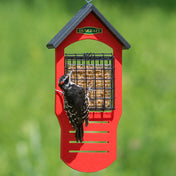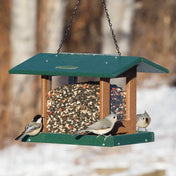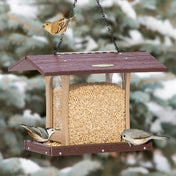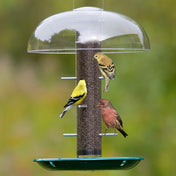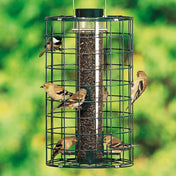When it comes to keeping squirrels off of their feeders, many backyard birders feel as though they have tried every trick in the books. After all, who among us has not witnessed these little acrobats fling themselves from impossible distances, hack through steadfast locking mechanisms, then proceed to ransack a feeder that was filled only minutes ago?
If you speak with an experienced backyard birder, they might tell you to “follow the 5-7-9 rule”. What is this rule, and how do you try it at home? We're here to bring some clarity to this topic, and to teach you about this foolproof strategy that will keep squirrels off your feeder for good.
A quick disclaimer - The rule discussed in this article is effective for keeping gray squirrels and red squirrels off of your feeder. Unfortunately, this might not work 100% of the time when it comes to flying squirrels.
While there are going to be exceptions to any rule, we have found this strategy to be quite effective, with many customers sharing the same sentiments after implementing it in their own backyards. Let’s jump in!

What is the 5-7-9 Rule for Squirrels?
This rule takes into consideration the maximum distance that your typical squirrel is capable of jumping. Each number in the rule corresponds with a different angle of approach that a squirrel might take in order to get to the free meal in your feeder. Birders will need to prepare for a squirrel to jump from any nearby location, including from above, from below, or from some object positioned horizontally to your feeder.
5 Feet From Below
Squirrels possess a mighty vertical leap for their size, ascending to heights of 4 to 5 feet when lifting off from the ground. If you consider that a fully grown squirrel might stand at just 6 inches tall when on all four legs, that means some squirrels can jump about 10 times higher than their own height. That’s why we recommend hanging your feeder at least 5 feet in the air, measuring from the ground to the base of the feeder. This should prevent any of these furry athletes from accessing your feeder from below. Of course, this strategy will only be useful if the squirrel can't shimmy right up the pole that the feeder is hanging from. A squirrel baffle will be a necessary component of your defense system if you do intend to hang your feeder from a pole.

7 Feet From Nearby Objects
Once they have failed to jump straight up to your feeder, clever squirrels will scour the surrounding area for higher terrain. Deck railings, picnic tables, and even small shrubs near your feeder will be utilized as makeshift launch pads. When leaping horizontally, squirrels can achieve a distance of about 7 feet. Keep this in mind when choosing a location for your feeder, aiming to create an obstacle-free perimeter of at least 7 feet surrounding all sides of the feeding station.
9 Feet From Above
Squirrels are arboreal critters, meaning they live in and rely on trees for their survival. As such, they are well adapted for making heroic leaps of faith from one branch to the next. While their death-defying shenanigans might be entertaining to watch, they also make squirrels well suited for dropping right onto your feeder from an overhanging branch. With a fair bit of trial and error, we have determined that a feeder is safe from aerial invasion as long as it is placed at least 9 feet below any tree branches. This gap seems to be just large enough to dissuade any would-be skydivers from making the risky plummet from above.

Summing Up
Here at Duncraft, we have provided advice to our customers about dealing with squirrels for over 70 years. We hope this latest installment in our ongoing collection of birding tips will prove useful to those who are still trying to deter squirrels from your feeders. If you are interested in trying out some more strategies, we carry a variety of unique solutions for this challenge, from hot pepper foods to durable squirrel-stopping bird feeder stations. You can also browse our full collection of squirrel-proof feeders, including our own line of time-tested cage-feeders. Lastly, we know that some folks will simply decide to accept the fluffy litter critters into their backyard family. If this sounds like you, then we’ve got a ton of products designed to help you cater directly to the squirrels - after all, they are pretty cute.
Thanks for reading, and happy birding!


